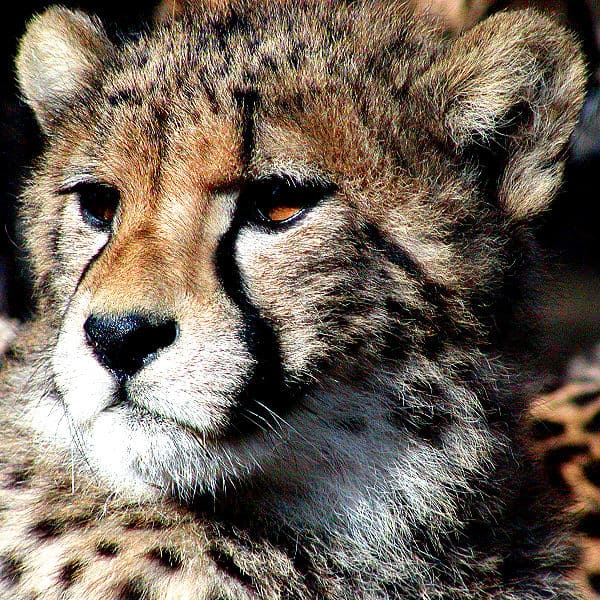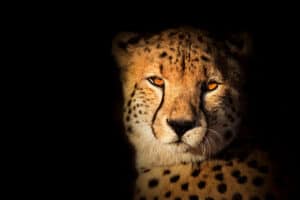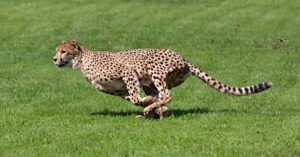Cheetahs depend on their running speed for food. They need to run fast enough to chase down small prey by themselves, because many cheetahs hunt alone. A cheetah (Acinonyx jubatus), the world’s fastest land animal, can run up to 75 miles per hour (mph). Their bodies are built for speed, from head to toe. A cheetah can increase its speed up to 70 mph in three seconds!
How Are Cheetahs Built for Speed?

Cheetahs are athletic creatures with powerful features.
©Wayne Marinovich/Shutterstock.com
The secret of a cheetah’s speed is in a body unlike that of any other cat. Smithsonian cheetah biologist Adrienne Crosier notes, “Everything about their body is designed for them to reach very quick speeds in a very short period of time.” The parts of a cheetah’s body that help it run so fast, according to Crosier and others, include:
Overall Muscle Mass
About half of a cheetah’s body mass is muscle. More muscle means more power and less drag when the cheetah runs.
Muscle Fibers
In a cheetah’s hind legs, over 80% of the muscle at the top comprises fast-twitch muscle fibers. These contract more quickly than other muscle fibers in the body, which in turn contributes to cheetahs’ incredible speed.
Specific Muscles
The psoas muscle is notably large in the cheetah. This muscle both extends the hip and pulls it back very quickly. When a cheetah pushes off with their hind legs, the larger psoas muscle gives each jump more power. Photos of cheetahs running often show all four of their legs off the ground at once.
Feet and Claws
On a cheetah’s feet, the nails stay extended; they never retract like those of most other cats. The extended claws behave like cleats when a cheetah sprints. If you watch a cheetah in motion, it doesn’t go in a straight line; when prey tries to escape, it may zig-zag. The cheetah in pursuit runs very low, almost touching the ground as it turns. A cheetah can turn quickly because the claws on its feet give it traction and stability.
A Special Claw
Cheetahs’ front feet have four normal toes and, further up the leg, a dewclaw, which they use to trap their prey when they’re chasing it. The dewclaw is similar to the human thumb as differentiated from the other fingers on a human hand. Cheetahs hook the back or legs of their prey with that dewclaw, causing the animal to stumble. Then the cheetah can finish the kill. Or, if they are training cubs to hunt, their cubs can complete the process.
Eyes
Cheetahs hunt based on what they can see, in contrast to animals who hunt based on smell. The cheetah’s large eye sockets, forward-facing eyes, and elongated retinal shape (which creates a wide-angle view) give them better vision. The dark markings below the eyes on a cheetah’s face reduce sun glare.

The dark tear marks below the cheetah’s eyes reduce sun glare.
©Erik Damen / CC0 – License
Spine
A very flexible spine allows the cheetah to move quickly and zig-zag when chasing prey. The spinal muscles help it extend and flex so the cheetah can stretch out while sprinting and make longer strides. A rescue organization notes, “A stride is the measured distance between successive imprints of the same paw. With the added reach given by the spine, 1 stride can stretch as far as 7-8 meters.”
Tail
A cheetah’s tail, muscular and long in proportion to body size, acts as a rudder when the cheetah is chasing its prey. It also helps the cheetah keep its balance while sprinting and when turning quickly.
Skull
The rounded, concave shape of a cheetah’s head makes it aerodynamic, which helps the cheetah run faster. Contrast it with the heads of other big cats, who do not need so much aerodynamic help.
Teeth
Cheetahs have to eat very quickly, so they can get their fill before another animal steals their hard-earned prey. Their teeth can tear muscle meat efficiently, so cheetahs ingest as much as possible as fast as they can. Cheetahs can eat up to 10 or 15 pounds of food (as much as 15% of their body mass) at one time. Because they eat so fast, cheetahs end up consuming only about 40% of what they kill (if they are hunting alone). Hyenas, on the other hand, eat as much as 80% of an animal, in part because their teeth can crack through bones.
How Does a Cheetah’s Speed Help It Survive?
Cheetahs would hunt differently if they were bigger (like tigers), hunted in groups (like lions), or had sharp enough claws to climb trees (as leopards do). Without these advantages, they need speed to catch food. A mother cheetah who is nursing cubs may leave them for up to two days as she hunts to find enough nutrition for herself. Male cheetahs do not raise their cubs; mothers raise cubs alone (as a consequence, comparatively few cheetah cubs grow to adulthood). The mother cheetah may move her cubs regularly to keep predators from catching their scent, and she may also wait until dark to return to her cubs in case predators are watching (hyenas, lions, jackals, and birds of prey hunt cheetah cubs).
Male cheetahs may sometimes hunt in groups, called coalitions. Cheetah cubs leave their mother within two years of birth. Male cubs often remain together in a coalition, and female cubs may establish a hunting territory close to that of the mother cheetah. Males in a coalition can cover a larger territory and hunt larger animals by chasing them from different directions.

The band of light fur on a cheetah cub’s back acts as camouflage, protecting them from other predators.
©Stu Porter/Shutterstock.com
Why Can’t Cheetahs Run for Long?
The downside of being built for speed is that a cheetah has little endurance. The cheetah has been likened to a sprinter, whereas other animals might be more like marathon runners. According to Big Cat Rescue, “The cheetah…can only run for short sprints of up to 300 yards. These sprints will usually last for 20 seconds, but rarely ever reach a full minute.” This is why cheetahs try to take prey by surprise, and aim for smaller prey — they are more likely to catch an animal under these conditions by outrunning it.
Aspects of a cheetah’s build that affect its endurance include:
Chest Cavity
The cheetah has a free-floating breastbone providing flexibility to stretch out its stride while running. This also gives more room for the cheetah’s lungs to expand. Cheetahs run faster than humans because they can breathe up to six times faster than we can. A cheetah breathes so hard while it is chasing prey that it must catch its breath and slow down its heart (sometimes for as long as 30 minutes!) before it can eat.
Internal Organs
The cheetah has an oversized liver, heart, lungs, and adrenal glands to help them speed up quickly.
Cooling Off
A cheetah’s body temperature goes up so high during fast sprints that it has to cool down before it can consume its food. It may pant like a dog to cool off, releasing heat through its mouth. Cheetahs can even release heat through their feet. Some believe cheetahs’ spots also help them cool off. “The hairs of the black spots are actually longer than the hairs that are the yellowish to orange color,” says Crosier. “Those longer hairs are thought to help disperse and release the heat.”
A Vulnerable Species
The cheetah was assessed in 2021 for the International Union for Conservation of Nature and Natural Resources (ICUN) Red List and determined to be vulnerable. Cheetahs used to live in a much broader range of places than they do now. Cheetahs’ historical range included most of Africa and the Middle East, extending into Turkmenistan Afghanistan, Pakistan, and India. Fossils reportedly have been found in China, Northern India, Southern Europe, and even as far as the Western United States. But cheetahs now live in only 9% of their historical range, and fewer than 10,000 of the cats exist in the wild. One species, the Asiatic cheetah, is nearly extinct, surviving only in portions of Iran.
Conservation organization Panthera.org summarizes several threats to cheetahs. “The illegal wildlife trade, loss of prey due to overhunting and poaching by people, conflict with local people, and loss and fragmentation of habitats to agricultural land developments and urbanization,” Panthera says. “Together, we protect cheetahs by addressing direct and indirect threats to them across their range, including illegal poaching, reduction of their prey base and habitat fragmentation.” Lack of genetic diversity also threatens cheetahs so their numbers in the wild continue to fall.
The photo featured at the top of this post is © iStock.com/slowmotiongli
Thank you for reading! Have some feedback for us? Contact the AZ Animals editorial team.






